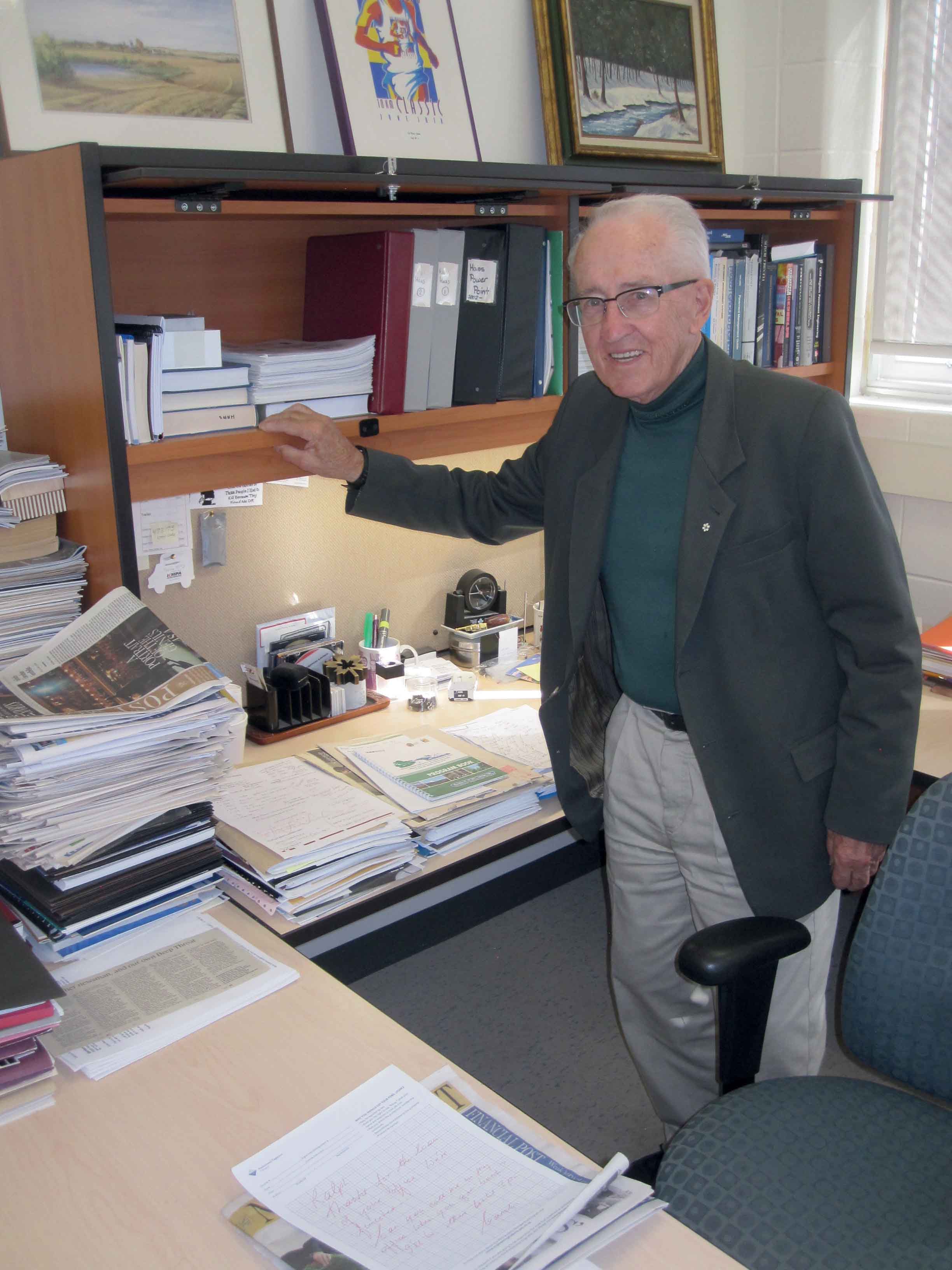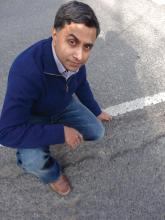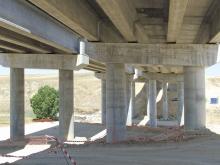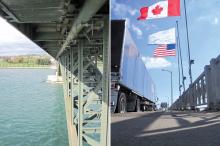World Highways caught up with man who developed the concept of asset management for roads in the 1960s. Dr Ralph Haas is still researching in his native Canada, and commenting on potholes.
The e-mail was brief. “You won't believe this, but I think I'm the last person on the planet without a cell phone.”
That was quite an admission from Ralph Haas, distinguished Canadian professor emeritus. He was one of several civil engineers in the 1960s who developed the concept of managing roads as an integrated

Dr Ralph Haas
World Highways caught up with man who developed the concept of asset management for roads in the 1960s. Dr Ralph Haas is still researching in his native Canada, and commenting on potholes.
The e-mail was brief. “You won't believe this, but I think I'm the last person on the planet without a cell phone.”
That was quite an admission from Ralph Haas, distinguished Canadian professor emeritus. He was one of several civil engineers in the 1960s who developed the concept of managing roads as an integrated transportation asset and not simply as a stand-alone object.
“Nope, never had a cell phone, even though my kids are after me to get one,” he says, over lunch at the University of Waterloo’s faculty club. “I like being less reachable. As a young guy on survey crews in northern Alberta [province], not having phones was a blessing because it put us far away from head office. They would send a telegram to the local railroad station, saying please phone in.”
Asset management for road is today taken for granted by not just engineers worldwide but governments of every persuasion. However, it was out-of-the-box thinking in the 1960s. Since then, Haas, working with close associates, has written or co-authored more than a dozen books on infrastructure management for roads and contributed to over 400 other publications on the subject.
For his efforts Haas has received international acclaim, as well as in Canada, a country which was knitted together by a continuously paved road from Pacific to Atlantic coasts only in 1971 - the 8,030km TransCanada Highway system. Accolades include honorary life member of the Transportation Association of Canada, the Canadian Technical Asphalt Association and, in the United States, the International Society for Asphalt Pavements and the Association of Asphalt Paving Technologists.
The latest contribution to a book for the 84-year-old was only last year. Haas still has an office and laboratory in the engineering department of Canada’s University of Waterloo, in the province of Ontario. He admits to not being there every day, but still carries on some research.
Haas was born in north-western Alberta, in the isolated hamlet of Dixonville, along the Mackenzie Highway. Dixonville’s population even now is only around 100. He recalls attending school where six grades were crowded into a one-room schoolhouse near the town of Peace River. In the late 1940s he started right out of high school as a 16-year-old on road survey crews for the provincial Alberta Highways department.
“I worked in every small town in the province, staying several months in one place, from near the Unied States border up to the border with the NorthWest Territories. A lot of survey work back then was for new roads straight through the bush. It was expansion of the system and rehabiltiating roads came later. We lived in isolated work camps where any guy who made moonshine was very popular with us.”
In those days, a surveyor was called an engineer, although he wasn’t a registered engineer. “Even the senior administrators were practical guys who learned everything on the job working their way up the ranks.”
But by the early 1950s, Haas noticed an increasing number of young university-trained engineers arriving in camp. “I saw a limit to what you could do as a highschool grad,” he says.
“I worked for eight and half years, then in 1957 I got married and a month later I started civil engineering at the University of Alberta in Edmonton.” He stayed on to complete a masters degree and gained more practical experience employed by the Research Council on road survey work during the summer breaks.
After a stint teaching at Carelton University in the capital city Ottawa, he opted for PhD work at the University of Waterloo where he has remained ever since.
All research is difficult, but putting together the idea of asset management for roads was “a real struggle”, he says. It simply didn’t exist. You laid down pavement, you repaired it or tore it up. Understanding that a road was part of a larger whole and not just a strip of ashphalt was very, very new. Strategic managmenet was needed to get the best value from the initial investment. It sounds common sense today, but back then it required new thinking,” he says.
The boom in road building in Canada aand the US after the Second World War meant that a liability was being created. Remember, expectations of a road lasting 10 years before major intervention was the norm, he explains. “You just built it and saw what happened. Much of the research was about a road’s sub-structure, soils, sub-grade, drainage, slope stability. The sciences of engineering of materials, structural design, construction methds and long-term performance predictions were still to come.”
Organisationally, highways were owned by the transport department and other government agencies wanted, and had, little to do with road performance or costs.
“We thought there had to be a way to improve road performance by tieing together planning activities, business principles, life cycle economics, financial accounting and any technical and related business activities. A road is just as much a business activity as a concrete structure that got there by way of technical expertise,” he says.
To promote the concept, Haas and two of his PhD students formed a company called Pavement Management Sytems, in the 1970s. Haas recalls the experience: “We were technically good, but business wise, we were very naive.” However, the company did “reasonably well” and grew to about 40 people. The first clients were the governments of Canada’s northern Northwest Territories, that of Alberta and Prince Edward Island provinces, as well as the northern US state of Idaho.
Eventually, Haas sold out to a local Alberta engineering business called4873 Stanley Technologies, which had around 150 employees. Stantec is now an award-winning international integrated infrastructure business with around 15,000 employees in 250 locations.
A big issue for early adopters of the concept was a lack of data about long-term pavement performance upon which to base predictions and best value economics. “Life cycle analysis needs good models in order to predict performance. But you need data on different materials, different structures, traffic loadings, environmental conditions, traffic volumes to créate those models.”
For example, he says, polymer modifications for bitumen have pushed outward the boundaries of highway performance. Quality control of batching is extemeley critical because of the effect on the life cycle management of that soon-to-be asset. This has also driven the tremendous increase in automation of asphalt plants.
“When you place hotmix, one of the big issues has always been segregation. You can’t see it with the eye, but the use of infrared imaging shows where the relative cold spots are. Because you see the exact problem, this has driven improvements in asphalt plant mixing and laying.” (The University of Waterloo recently named “The Ralph Haas Infrastructure and Sensing Analysis Laboratory” in his honour.)
His research has included long-term comparisons of concrete and asphalt roads and he remains neutral over their use. Over a 50-year cycle, the difference in perfomance between them is ”almost insignificant”, he says. “But I’ve always argued that it is good for the concrete and asphalt guys to compete with each other.”
However, historically, cement has been used much less in Canada than in the US, with the exception of Winnipeg, a city in the province of Manitoba (see box). “Advances in concrete pavement have been enormous in the past 40 years, primarily in joint design. When joints start deteriorating, that’s a helluva big fix. With many load transfer devices now available, concrete paving is really well advanced.”
But initially, back in the 1960s, traffic volume estimates were not very accurate. Concete roads often had plain joints which couldn’t take the unforeseen higher traffic volumes and increasing vehicular weights. Retroffiting joints with load transfer devices was, and remains, very expensive, he says. There was also the issue of what raw materials such as aggregates were easily available in many of Canada’s more remote áreas. That determined out of what a road would be made.
For many years Haas taught a course on designing roads for arctic conditions. “Permafrost. It’s not be trifled with,” he says. “You work with it, not against it. If you mess up a permafrost’s thermal regime you get un-natural thaws which result in absoutely horrible road breakups. Always preserve as much permafrost as you can,” he warns.
Bedtime Reading
PAVEMENT ASSET MANAGEMENT
John Wiley & Sons (2015)
MODERN PAVEMENT MANAGEMENT
Krieger Publishing Company (1994)
PAVEMENT MANAGEMENT SYSTEMS
McGraw-Hill (1978)
REINVENTING THE PAVEMENT MANAGEMENT WHEEL
Distinguished Lecture presented at 5th International Conference on Managing Pavements, in Seattle, US (2001)
PUBLIC INFRASTRUCTURE ASSET MANAGEMENT
2nd ed., McGraw-Hill (2013)
PAVEMENT DESIGN
Chapter 13 in Geotechnical and Geo-environmental Handbook; Kluwer (2001)
TRACKING SECONDARY AND TEMPORARY CONCRETE CONSTRUCTION OBJECTS USING 3D IMAGING
Chapter in Computing in Civil Engineering: American Society of Civil Engineers (2013)“Fortunately, with good road design you move the permafrost active zone up into the road’s grade itself. Here you have good stable granular material which is what then thaws and freezes.”
For the airport runway in the town of Inuvik - 200km above the Arctic Circle - the permafrost’s active zone (the top section susceptible to thawing in summer) has been moved up into the road fill. What thaws in summer is only the road fill, leaving the underlying permafrost frozen and so it maintains a solid base during the warm period.
As the cost of building new roads becomes increasingly prohibitive to fund solely from a tax base, he sees more privately owned toll roads being built globally. They all have benefited from the concept of asset management which allows a business case to be built around their construction and maintenance. Australia's2378 Macquarie Group and Spain's 2717 Ferrovial Group, to name a few global companies, have assembled vast portfolios of toll roads, often financing them with heavy debt based on assumptions that rising toll receipts will offset maintenance costs and pay down the debt.
But much of the business case now depends on traffic volume assumptions and it is no longer a case of ‘build it and they will come’, he warns. In some regions, such as in Africa, prediction of traffic volumes is not accurate and offshore money is cheap, such as from China, so invstors should be cautious.
What is the best advice that he gives his new students today? “I tell them that one day they will all be taxpayers and a good knowledge of roads will make them better citizens.”
Beware snake-oil salesmen
Dr. Haas admits to taking pictures of potholes, but for academic purposes only, he claims. Canadian media also want his comments on potholes. “Every spring the phone rings and they ask the same old question, what causes potholes. They want me to say it’s faulty design. But the reality is it’s a lot of things.”
With the development of so-called throw-n-go filling material, dozens of companies are running around selling their magic pothole patcher. “Beware of magic material promises, in the geosynthetics area,” he says. “County engineers are bombarded with them. Some material is very good, but there is such an element of snake-oil that it’s hard for buyers to know what is best. Oh, and manufacturers show you how well it works….in the summer.”
The honour roll
Dr. Ralph Haas is the Norman W. McLeod Engineering Professor and Distinguished Professor Emeritus in the Department of Civil Engineering at the University of Waterloo. He also hold the country's highest civilian honour, the Order of Canada; the highest academic honour, Fellow of the Royal Society of Canada; and the highest engineering honour, Fellow of the Canadian Academy of Engineering. In 2014 he received the US National Academies Transportation Research Board’s highest honour, the Roy W. Crum Award for Outstanding Achievement in Transportation Research.
He is also a Fellow of the Engineering Institute of Canada and a Fellow of the Canadian Society for Civil Engineering. Dr. Haas was the first recipient of the Canadian Society for Civil Engineering's Sandford Fleming Award for "outstanding contributions to research and education in the field of transportation engineering".
Winnipeg loves concrete
Winnipeg, the capital of Manitoba province, has more than 4,600 lane-km of concrete residential street pavement, according to information from the Canadian Cement Association in 2010. Plus there are nearly 700 lane-km of lanes behind houses and 1,600 lane-km of arterial roads.
City and provincial engineers had included a so-called elastic joint in the slabs. Reinforced steel mats of 15m smooth steel bars are spaced at 500mm in both directions within the slab. An extra 300mm of these bars extends into the adjacent panel, as a substitute for dowels. This design is used increasingly on residential streets, along with plain - meaning unreinforced - slabs with or without dowels.
The e-mail was brief. “You won't believe this, but I think I'm the last person on the planet without a cell phone.”
That was quite an admission from Ralph Haas, distinguished Canadian professor emeritus. He was one of several civil engineers in the 1960s who developed the concept of managing roads as an integrated transportation asset and not simply as a stand-alone object.
“Nope, never had a cell phone, even though my kids are after me to get one,” he says, over lunch at the University of Waterloo’s faculty club. “I like being less reachable. As a young guy on survey crews in northern Alberta [province], not having phones was a blessing because it put us far away from head office. They would send a telegram to the local railroad station, saying please phone in.”
Asset management for road is today taken for granted by not just engineers worldwide but governments of every persuasion. However, it was out-of-the-box thinking in the 1960s. Since then, Haas, working with close associates, has written or co-authored more than a dozen books on infrastructure management for roads and contributed to over 400 other publications on the subject.
For his efforts Haas has received international acclaim, as well as in Canada, a country which was knitted together by a continuously paved road from Pacific to Atlantic coasts only in 1971 - the 8,030km TransCanada Highway system. Accolades include honorary life member of the Transportation Association of Canada, the Canadian Technical Asphalt Association and, in the United States, the International Society for Asphalt Pavements and the Association of Asphalt Paving Technologists.
The latest contribution to a book for the 84-year-old was only last year. Haas still has an office and laboratory in the engineering department of Canada’s University of Waterloo, in the province of Ontario. He admits to not being there every day, but still carries on some research.
Haas was born in north-western Alberta, in the isolated hamlet of Dixonville, along the Mackenzie Highway. Dixonville’s population even now is only around 100. He recalls attending school where six grades were crowded into a one-room schoolhouse near the town of Peace River. In the late 1940s he started right out of high school as a 16-year-old on road survey crews for the provincial Alberta Highways department.
“I worked in every small town in the province, staying several months in one place, from near the Unied States border up to the border with the NorthWest Territories. A lot of survey work back then was for new roads straight through the bush. It was expansion of the system and rehabiltiating roads came later. We lived in isolated work camps where any guy who made moonshine was very popular with us.”
In those days, a surveyor was called an engineer, although he wasn’t a registered engineer. “Even the senior administrators were practical guys who learned everything on the job working their way up the ranks.”
But by the early 1950s, Haas noticed an increasing number of young university-trained engineers arriving in camp. “I saw a limit to what you could do as a highschool grad,” he says.
“I worked for eight and half years, then in 1957 I got married and a month later I started civil engineering at the University of Alberta in Edmonton.” He stayed on to complete a masters degree and gained more practical experience employed by the Research Council on road survey work during the summer breaks.
After a stint teaching at Carelton University in the capital city Ottawa, he opted for PhD work at the University of Waterloo where he has remained ever since.
All research is difficult, but putting together the idea of asset management for roads was “a real struggle”, he says. It simply didn’t exist. You laid down pavement, you repaired it or tore it up. Understanding that a road was part of a larger whole and not just a strip of ashphalt was very, very new. Strategic managmenet was needed to get the best value from the initial investment. It sounds common sense today, but back then it required new thinking,” he says.
The boom in road building in Canada aand the US after the Second World War meant that a liability was being created. Remember, expectations of a road lasting 10 years before major intervention was the norm, he explains. “You just built it and saw what happened. Much of the research was about a road’s sub-structure, soils, sub-grade, drainage, slope stability. The sciences of engineering of materials, structural design, construction methds and long-term performance predictions were still to come.”
Organisationally, highways were owned by the transport department and other government agencies wanted, and had, little to do with road performance or costs.
“We thought there had to be a way to improve road performance by tieing together planning activities, business principles, life cycle economics, financial accounting and any technical and related business activities. A road is just as much a business activity as a concrete structure that got there by way of technical expertise,” he says.
To promote the concept, Haas and two of his PhD students formed a company called Pavement Management Sytems, in the 1970s. Haas recalls the experience: “We were technically good, but business wise, we were very naive.” However, the company did “reasonably well” and grew to about 40 people. The first clients were the governments of Canada’s northern Northwest Territories, that of Alberta and Prince Edward Island provinces, as well as the northern US state of Idaho.
Eventually, Haas sold out to a local Alberta engineering business called
A big issue for early adopters of the concept was a lack of data about long-term pavement performance upon which to base predictions and best value economics. “Life cycle analysis needs good models in order to predict performance. But you need data on different materials, different structures, traffic loadings, environmental conditions, traffic volumes to créate those models.”
For example, he says, polymer modifications for bitumen have pushed outward the boundaries of highway performance. Quality control of batching is extemeley critical because of the effect on the life cycle management of that soon-to-be asset. This has also driven the tremendous increase in automation of asphalt plants.
“When you place hotmix, one of the big issues has always been segregation. You can’t see it with the eye, but the use of infrared imaging shows where the relative cold spots are. Because you see the exact problem, this has driven improvements in asphalt plant mixing and laying.” (The University of Waterloo recently named “The Ralph Haas Infrastructure and Sensing Analysis Laboratory” in his honour.)
His research has included long-term comparisons of concrete and asphalt roads and he remains neutral over their use. Over a 50-year cycle, the difference in perfomance between them is ”almost insignificant”, he says. “But I’ve always argued that it is good for the concrete and asphalt guys to compete with each other.”
However, historically, cement has been used much less in Canada than in the US, with the exception of Winnipeg, a city in the province of Manitoba (see box). “Advances in concrete pavement have been enormous in the past 40 years, primarily in joint design. When joints start deteriorating, that’s a helluva big fix. With many load transfer devices now available, concrete paving is really well advanced.”
But initially, back in the 1960s, traffic volume estimates were not very accurate. Concete roads often had plain joints which couldn’t take the unforeseen higher traffic volumes and increasing vehicular weights. Retroffiting joints with load transfer devices was, and remains, very expensive, he says. There was also the issue of what raw materials such as aggregates were easily available in many of Canada’s more remote áreas. That determined out of what a road would be made.
For many years Haas taught a course on designing roads for arctic conditions. “Permafrost. It’s not be trifled with,” he says. “You work with it, not against it. If you mess up a permafrost’s thermal regime you get un-natural thaws which result in absoutely horrible road breakups. Always preserve as much permafrost as you can,” he warns.
Bedtime Reading
PAVEMENT ASSET MANAGEMENT
John Wiley & Sons (2015)
MODERN PAVEMENT MANAGEMENT
Krieger Publishing Company (1994)
PAVEMENT MANAGEMENT SYSTEMS
McGraw-Hill (1978)
REINVENTING THE PAVEMENT MANAGEMENT WHEEL
Distinguished Lecture presented at 5th International Conference on Managing Pavements, in Seattle, US (2001)
PUBLIC INFRASTRUCTURE ASSET MANAGEMENT
2nd ed., McGraw-Hill (2013)
PAVEMENT DESIGN
Chapter 13 in Geotechnical and Geo-environmental Handbook; Kluwer (2001)
TRACKING SECONDARY AND TEMPORARY CONCRETE CONSTRUCTION OBJECTS USING 3D IMAGING
Chapter in Computing in Civil Engineering: American Society of Civil Engineers (2013)“Fortunately, with good road design you move the permafrost active zone up into the road’s grade itself. Here you have good stable granular material which is what then thaws and freezes.”
For the airport runway in the town of Inuvik - 200km above the Arctic Circle - the permafrost’s active zone (the top section susceptible to thawing in summer) has been moved up into the road fill. What thaws in summer is only the road fill, leaving the underlying permafrost frozen and so it maintains a solid base during the warm period.
As the cost of building new roads becomes increasingly prohibitive to fund solely from a tax base, he sees more privately owned toll roads being built globally. They all have benefited from the concept of asset management which allows a business case to be built around their construction and maintenance. Australia's
But much of the business case now depends on traffic volume assumptions and it is no longer a case of ‘build it and they will come’, he warns. In some regions, such as in Africa, prediction of traffic volumes is not accurate and offshore money is cheap, such as from China, so invstors should be cautious.
What is the best advice that he gives his new students today? “I tell them that one day they will all be taxpayers and a good knowledge of roads will make them better citizens.”
Beware snake-oil salesmen
Dr. Haas admits to taking pictures of potholes, but for academic purposes only, he claims. Canadian media also want his comments on potholes. “Every spring the phone rings and they ask the same old question, what causes potholes. They want me to say it’s faulty design. But the reality is it’s a lot of things.”
With the development of so-called throw-n-go filling material, dozens of companies are running around selling their magic pothole patcher. “Beware of magic material promises, in the geosynthetics area,” he says. “County engineers are bombarded with them. Some material is very good, but there is such an element of snake-oil that it’s hard for buyers to know what is best. Oh, and manufacturers show you how well it works….in the summer.”
The honour roll
Dr. Ralph Haas is the Norman W. McLeod Engineering Professor and Distinguished Professor Emeritus in the Department of Civil Engineering at the University of Waterloo. He also hold the country's highest civilian honour, the Order of Canada; the highest academic honour, Fellow of the Royal Society of Canada; and the highest engineering honour, Fellow of the Canadian Academy of Engineering. In 2014 he received the US National Academies Transportation Research Board’s highest honour, the Roy W. Crum Award for Outstanding Achievement in Transportation Research.
He is also a Fellow of the Engineering Institute of Canada and a Fellow of the Canadian Society for Civil Engineering. Dr. Haas was the first recipient of the Canadian Society for Civil Engineering's Sandford Fleming Award for "outstanding contributions to research and education in the field of transportation engineering".
Winnipeg loves concrete
Winnipeg, the capital of Manitoba province, has more than 4,600 lane-km of concrete residential street pavement, according to information from the Canadian Cement Association in 2010. Plus there are nearly 700 lane-km of lanes behind houses and 1,600 lane-km of arterial roads.
City and provincial engineers had included a so-called elastic joint in the slabs. Reinforced steel mats of 15m smooth steel bars are spaced at 500mm in both directions within the slab. An extra 300mm of these bars extends into the adjacent panel, as a substitute for dowels. This design is used increasingly on residential streets, along with plain - meaning unreinforced - slabs with or without dowels.










